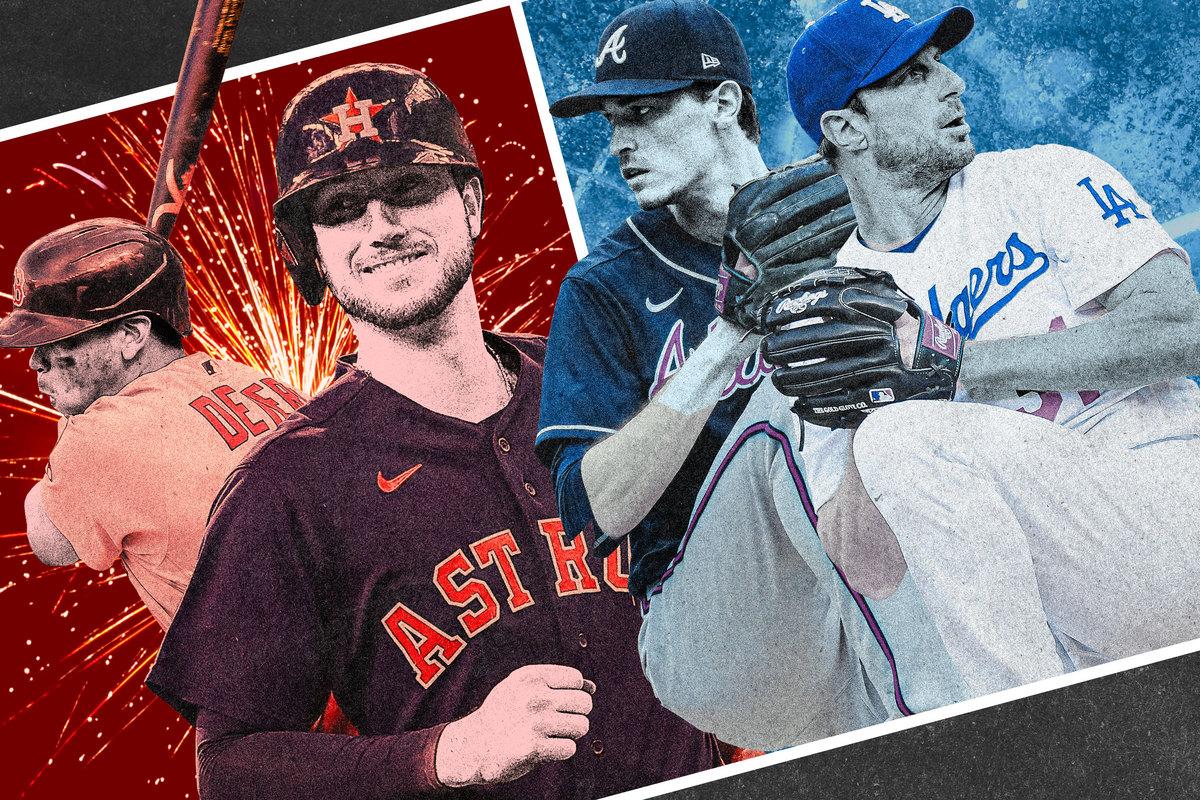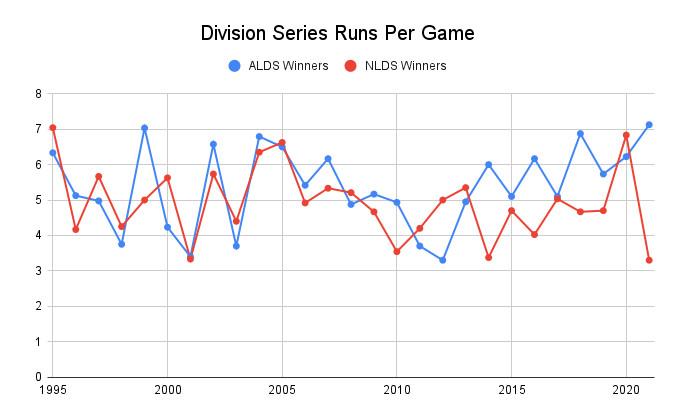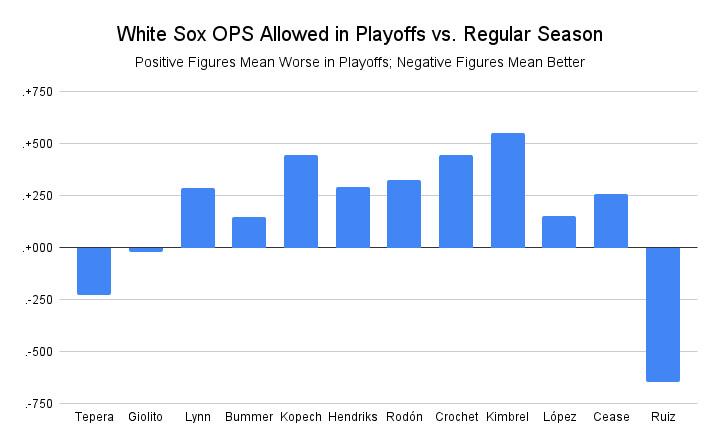
Not much distinguishes the National and American Leagues anymore. In decades past, the two leagues were far more separate: separate season lengths at times, separate league presidents, even separate umpiring crews. But nowadays, the only real difference is that one league uses the designated hitter while one does not (for now). And even that difference doesn’t mean all that much: In 2021, NL clubs scored 97 percent as many runs as their AL counterparts.
But thus far in the 2021 playoffs, the two leagues’ aesthetics couldn’t look more disparate. The Red Sox and Astros averaged 7.1 runs per game in their divisional series triumphs—the highest average for any pairing of championship series opponents in the wild-card era.
Meanwhile, Atlanta and Los Angeles were down at just 3.3 runs per game—tied for the lowest average for any pairing of championship series opponents. (To compute these figures, we averaged the two teams’ averages, to avoid giving extra weight to teams that played more games.)

The differences between the two leagues stand out on a granular level, as well. Nine starters in the divisional series lasted at least six innings—eight of them from the National League. Conversely, 15 of the top 20 qualified divisional series batters in OPS are in the AL. And the divergent offensive levels have produced different game experiences: The average ALDS game time was 4 hours, 1 minute (or 3 hours, 50 minutes if the 13-inning game is removed), while the average NLDS contest lasted “just” 3:19.
And as the collective baseball world attempts to calm down from the thrills of Dodgers-Giants Game 5—plus its controversial ending—and look ahead to the next round, there’s no real reason to expect these trends to stop now.
In the regular season, the Rays and White Sox posted the lowest team ERAs in the American League. In the playoffs, they couldn’t get outs.
Boston pulled the upset over Tampa Bay because of its offense: Across games 2-4, the Red Sox pounded 47 hits—the second most for any team over any three-game span in playoff history. Young, electric Rays starters Shane McClanahan, Shane Baz, and Drew Rasmussen combined to allow 11 runs in 10 innings, for a 9.90 ERA.
Boston’s outburst was more surprising than Houston’s, given both the caliber of opponent and the lineup’s inconsistency in the second half of the season. But the Red Sox have more than enough talent to get hot all at once.
Xander Bogaerts and Rafael Devers are terrors in the middle of the order, as always, and Kyle Schwarber is an unorthodox but supremely effective leadoff man: Counting both the regular season and playoffs, Schwarber has a .432 on-base percentage with Boston. Plus the return of J.D. Martinez after a bizarre injury in the final weekend of the regular season—he tripped over second base while trotting out to the field between innings, then missed the wild-card game—lengthens Boston’s lineup considerably.
Now, with that quartet, Alex Verdugo, and Kiké Hernández, the Red Sox lineup boasts a formidable top six—especially if Hernández, ostensibly the weakest hitter in that group, slugs .900 as he did in the ALDS.
Houston, meanwhile, spent a week tormenting some awfully talented pitchers. The White Sox should place multiple pitchers on this year’s Cy Young ballots—yet in the ALDS, every Chicago starter was knocked out before completing five innings, and the best ERA among the bunch was 6.75. Overall, the starters combined for just 12 1/3 innings—barely more than three per game—with a 10.22 ERA and a 2.11 WHIP.
Almost every Chicago pitcher was significantly worse in the ALDS than in the regular season. Other than Ryan Tepera—a reliever who somehow led the White Sox in innings in the series, as the starters were knocked out so early—and José Ruiz, who threw once in a low-leverage situation, no Chicago player pitched well.

For the coup de grace, Houston scored three meaningless runs off Liam Hendriks in the ninth inning of the clincher. The Astros had already gotten to Garrett Crochet and Michael Kopech and Aaron Bummer and Craig Kimbrel in the series—why not the best closer in baseball for the finishing blow?
The Astros had the majors’ highest-scoring and best-hitting lineup in the regular season, and now they’re healthy and at full strength. Here’s how deep the position player core is: Kyle Tucker posted the best regular-season wRC+ for any qualifying hitter who reached the divisional round. (He was seventh overall, with a 147 mark, and all of the top six either didn’t make the playoffs or were eliminated in the wild-card round.) And in this Astros lineup, Tucker bats seventh.
Four different Astros—Yordan Álvarez, Jose Altuve, Carlos Correa, and Tucker—posted an OPS of 1.000 or better in the divisional round. That tally doesn’t even include Alex Bregman or Michael Brantley, who hit .375 and .368, respectively.
One more commonality between these lineups is their balance. Righty-lefty mixing isn’t necessary for a dominant offense—the Blue Jays, with all their righties, had the platoon advantage less often than any other team this season and scored just fine—but especially with the three-batter minimum for relief pitchers, it helps. And both the Astros and Red Sox mix the top of their orders with batters on both sides, which can lead to matchups like the lefty Crochet against right-handers Yuli Gurriel and Bregman in key situations. In both such circumstances in the ALDS, in games 2 and 4, respectively, the Astro with the platoon advantage knocked a two-run hit.
The National League playoffs have scrawled a rather different story. No team has scored double-digit runs in any game; the losing teams have scored, in ascending order:
0, 0, 0, 0, 1, 1, 1, 2, 2, 4
Atlanta and Los Angeles contributed to those lowly outputs even while advancing—yet it’s difficult to blame their offenses too much when considering the pitching they faced. Milwaukee’s tremendous rotation and back end of the bullpen made the Brewers a World Series favorite in some eyes (oops): Accordingly, Freddie Freeman and Austin Riley hit consistently throughout the NLDS, but no other regular Atlanta starter did. The team’s leader in RBI was Joc Pederson, who slugged two pinch-hit home runs, and nobody outside that trio hit a homer.
Meanwhile, the Dodgers were shut out in both of their losses, with a similar dearth of power to Atlanta: Mookie Betts and Will Smith were the only players to homer, or even hit well over multiple games. The absence of Max Muncy—who’s out after dislocating his elbow in Game 162—creates a giant (no pun intended) hole in the middle of the order, and for all the majesty of Cody Bellinger’s series-winning single, he still managed just a .600 OPS against San Francisco after posting one of the majors’ worst batting lines this season.
Both Atlanta’s and L.A.’s pitching staffs contributed to the dead ball–esque run environment, of course. Atlanta’s Max Fried and Ian Anderson didn’t allow a run in starts in games 2 and 3, respectively, and high-leverage relievers Will Smith, Luke Jackson, and Tyler Matzek combined for 10 2/3 scoreless innings in the series. In fact, Charlie Morton and Huascar Ynoa were the only Atlanta pitchers to allow any runs in the entire series.
And the Dodgers were even stingier than the Giants, holding the division rival to just 10 total runs across five games. Add in the team’s wild-card win over St. Louis, and it has a cumulative 1.87 playoff ERA. The top three starters are all capable of shutting down a lineup, even with Clayton Kershaw out with an elbow injury, and the top relievers are all clicking, as well: Like Atlanta’s back end of the bullpen, the combination of Kenley Jansen, Blake Treinen, Brusdar Graterol, and Corey Knebel hasn’t allowed a run yet this postseason in 15 innings.
Predicting anything in small samples of baseball is a fool’s errand, but it’s not hard to imagine the two leagues’ disparate offensive trends continuing in the championship series. In the AL, it’s possible to squint and find some soft spots in the lineup. Neither team typically receives much offensive production from its catchers (Christian Vazquez’s late-inning ALDS heroics aside), and Houston has a weak center field while Boston lacks thump at second base. Bobby Dalbec, Travis Shaw, and Hunter Renfroe can be very swing-and-miss—emphasis, against good pitching, on miss.
Yet even with those flaws, Boston and Houston just battered the two pitching staffs with the league’s lowest regular-season ERAs. Now they get to face theoretically easier pitching, as neither staff seems up to the task of slowing an offensive steamroller.
Houston will be without ALDS Game 1 starter Lance McCullers Jr., who left Game 4 early with a forearm injury, meaning two of the four regularly scheduled Astros starters—José Urquidy and whoever replaces McCullers—won’t have appeared in the victorious ALDS rotation. And it’s not as if those other two starters pitched all that well against the White Sox, either: Framber Valdez and Luis Garcia allowed a combined nine runs in seven innings.
Boston, meanwhile, retains a chaotic pitching situation. ALCS Game 1 starter Chris Sale didn’t make it to the second inning of his lone ALDS start. Red Sox relievers coughed up leads in the eighth inning of consecutive games. Nick Pivetta is somehow throwing crucial high-wire innings.
Garrett Whitlock is an excellent reliever, and Nathan Eovaldi, Tanner Houck, and Eduardo Rodríguez are all some combination of reliable and flexible in usage. But there aren’t too many arms on this Boston staff who seem like comfortable options against a lineup as frightening as Houston’s.
In the NL, Atlanta’s pitchers aren’t as good as San Francisco’s—the Dodgers will happily say goodbye to Logan Webb, who allowed just one run in 14 2/3 NLDS innings—and L.A.’s probably aren’t as good as Milwaukee’s. But it’s mighty close, and both teams should be able to start at least six out of a possible seven games with arms they trust.
Both defenses should help matters, too: The Dodgers had the majors’ best defensive efficiency in the regular season, which meant they turned the most balls in play into outs; in the playoffs, they didn’t commit a single error between the first inning of the wild-card game and the ninth inning of NLDS Game 5. Atlanta isn’t at the Dodgers’ level in this regard, but since moving to a shift-heavy strategy in May, its defense also rates as one of the best in the majors.
So over the next week-plus, tune in to the ALCS for runs and the NLCS for low-scoring nail-biters—or just watch all those games to get the variety. The 2021 MLB season is almost over, after all, so it makes sense to cram in as much entertainment as possible while you still can.

